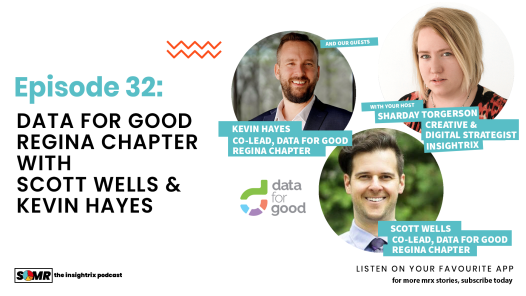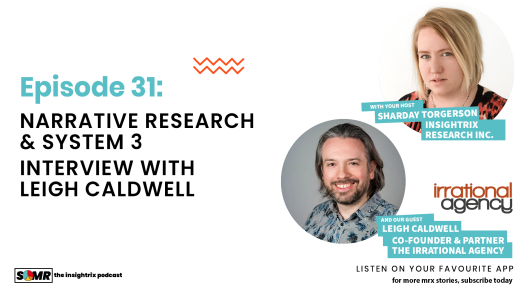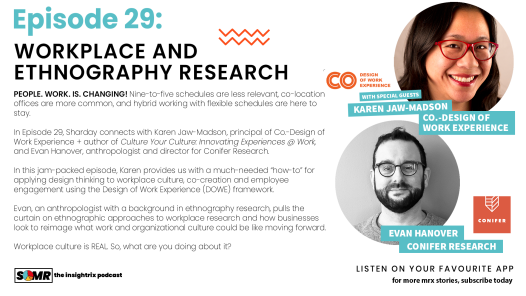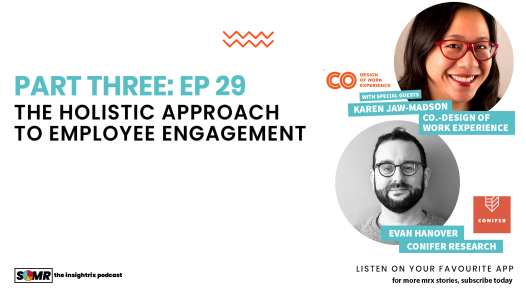You can also access SoMR on your favourite podcast player app like Apple Podcasts, Spotify or YouTube. Make sure you subscribe to be notified every time a new episode is published.
Evan Hanover:
Yeah, I think Karen has kind of mapped out probably the bulk of the next two sections that we want to talk about, which is what, putting insights aside, what-
Karen Jaw-Madson:
I didn’t mean to do that.
Evan Hanover:
No, I think…
Sharday Torgerson:
Natural segment, I am for it.
Evan Hanover:
I think [inaudible 00:00:22] would appreciate your foreshadowing going back to him. So first there are the data collection, right? What are you actually capturing? And then there’s the, however you want to call it, the activation and engagement with that data which includes insights, but also includes ownership, which is a big part of it.
Evan Hanover:
And I think because the people acting on the data are also the people… The people acting on the insights are the people who are going to be affected by the insights. Unlike very often if I’m studying soft drink consumption, that’s a very different beast because the people who are going to act on the insights are not going to be nearly as affected.
Evan Hanover:
So with the collection of the data, obviously I’m going to stump for anthropology and an ethnographic approach. And the reason I’m going to do that is because anthropology is by its nature holistic. So it’s going to combine things like interviews and observation and an understanding of space and a focus on communication, and mapping social roles and mapping life trajectories.
Evan Hanover:
I’ve referred to them like they’re career paths, but really they bear a very similar relationship to the way we think about life trajectories and you go through stages. I think we say things like late career and stuff like that. And we’re attuned to all these things and the signs and symbolism that go along with how the space is created, how people interact.
Evan Hanover:
And by being holistic, getting back to that foreground background thing, culture is something hard to articulate. The definition of it is hard to articulate as demonstrated in minute one of this interview, but also what it really is that comprises that culture is hard to articulate.
Evan Hanover:
If you went into an organization and asked, what is your culture? You’re going to get values that are everyone’s maybe screened background and that are painted in the lobby, but you’re not going to get really the experienced dynamic nature of it.
Karen Jaw-Madson:
Yeah, you’re getting [inaudible 00:02:49]
Evan Hanover:
Right. And what an ethnographic approach does is takes all of that information, looks at it holistically and is able to tease out the things that are tacit and unarticulatable and foreground them and make them data that you can really look at.
Evan Hanover:
The second part is, which is a fun part I think both for Karen and I to talk about, is that co-creative piece, is the idea that you need to give your employees a team who’s responsible for leading this initiative, the space to work.
Evan Hanover:
And space might be physical but it’s also temporal. They need the time to do it. It’s psychological and it’s political. It’s all of those things. You need to give them that space. You need to give a-
Karen Jaw-Madson:
And remove the barriers.
Evan Hanover:
Remove the barriers, and barriers are whole other podcast. Because those barriers can be access. They can be dissuasive or coercive factors, which may not even be on purpose. But basically you need to be able to tell the boss what’s wrong and you need to be able to say it as bluntly as possible. You also need to be, one of the barriers is secrecy, you need to be as transparent as possible.
Evan Hanover:
So one of the things that Conifer does is we will go, let’s say, we’re going to do research for a couple of weeks at an office to understand… We’ll interview people. We’ll observe. We’ll just kind of hang out and figure out what’s going on. And we will start to early analysis on some of the key themes, pain points, interactions.
Evan Hanover:
And then we usually are given a room to work in and then we will essentially have an open house and we will just have out our half formed ideas, which are usually on big post-it notes that we just put up on the wall and invite people to come in and critique us.
Evan Hanover:
Which does two things, it helps to validate or if we’re getting something totally wrong, which hopefully doesn’t happen, we can get that feedback, but also it’s data in itself in how people react to having a mirror reflected to them. And then you start to see how people are going to respond when you start to activate that work, which is where the co-creation comes in.
Evan Hanover:
And I think I’m going to just throw the ball over Karen who’s more than happy to talk about the kinds of co-creative processes you can bring in to that work to make sure that folks have ownership, they have a huge stake in this. People don’t want to work in crappy workplaces. I don’t know how to be more blunt than that.
Sharday Torgerson:
Same point.
Evan Hanover:
There’s your quote for the episode, people don’t want to work at crappy workplaces.
Sharday Torgerson:
Yap.
Karen Jaw-Madson:
Definitely need to clip that and put it in social media.
Sharday Torgerson:
Yeah, I think that’s a winner there, Evan. And I couldn’t agree more.
Karen Jaw-Madson:
Yeah. And I think what… And we talked about this before we started recording, but even though these are the starting points we’re talking about, it’s also the engagement part from the very, very beginning, right? So when you’re asking people for that you’re engaging them, how would you like to see this?
Karen Jaw-Madson:
Where are the friction points? Where is this accurate or not accurate? And by virtue of doing that, you are starting to co-create. Even in the research phase of the work, there is a co-creation stage, but this is all about weaving the experience and the co-creation together, right? So I’m highly influenced by appreciative inquiry, which talks about using the whole systems, right?
Karen Jaw-Madson:
Using all the ingenuity that comes within the whole systems to be able to inspire people to envision that shared future together, one that’s based on what’s inspirational as well as what’s based on the strengths, right? As opposed to we’re really good at pointing out what’s wrong, aren’t we? That’s what we’re trained to do, but we haven’t been trained on how to make it right, okay?
Karen Jaw-Madson:
And so co-creation processes engage people and leverages their talents, right? So that’s why the work I do not only builds capability, it uses capability and engages people throughout.
Sharday Torgerson:
Nice. Yeah, I think even speaking on our behalf at Insightrix, we recently moved our headquarters into a new space with a focus on a hybrid environment. And all of these things are ringing true in both the good and the bad.
Sharday Torgerson:
But I do find it interesting that even from the get go Insightrix really took it upon themselves to make sure that both transparency and collaboration was a big part of even deciding if we wanted to move, let alone coming up with a really key workspace that was built for everyone.
Sharday Torgerson:
We got everyone’s input and thus the space came to be. But what I did appreciate for the first year in 2020 was that essentially the facilities management team at Insightrix, which I mean, for lack of a better term is just the folks that really kind of focused on hopefully supporting the culture to some degree, especially during the move.
Sharday Torgerson:
But we really focused on doing just even simple surveys every month just to check in with the employees, but then also building on them to some degree. So that whole, what would our office look like in a perfect world?
Sharday Torgerson:
So what we did end up finding, which I thought was quite interesting is that the folks that maybe even two to three years ago that might have had even their own opinion on flexible work or remote working, or even being hybrid as a business were some of the first people to actually really get behind hybrid working and then also completely shift how they do their own work, which I thought was interesting.
Sharday Torgerson:
I’ve always been an advocate for remote work, so the pandemic kind of naturally fell into how I do things, but it was really interesting to see a lot of folks who maybe were in a little bit more of the traditional mindset when it comes to a workplace culture. Because again, I think a lot of that has to do with, Evan mentioned, the whole going around the water cooler and maybe discussing about last night’s Saturday’s game, because you both cheer for the same team.
Sharday Torgerson:
A lot of that is lost, but I know for us, we’re really looking at ways and how we can continue to keep that going. So I think you guys really kind of made that my personal experience come to forefront and now I’m thinking, yeah, I got a couple of ideas I’m going to take to Insightrix.
Evan Hanover:
So I think it’s important to ask why do people… I mean, I think no matter what the context is, it’s important to ask why. In some ways anthropologists are like two year olds. They just want to know why, why, why, why? But I think in this case there’s a lot to be learned about why people are preferring one mode or another.
Evan Hanover:
And this is not to say you have to give everybody everything they want, but Karen, I think you brought up before that, sometimes if you’re just going to willy-nilly be like, this is what we need to do. You’re going to get the reaction from folks, which is like, this makes no sense. This is a knee-jerk reaction that that is cobbled together and it doesn’t work for anybody let alone me.
Evan Hanover:
But I think if you understand why and you implement something transparently and fairly, you’re going to get a positive reception. But also it’s been interesting at Conifer as I’m also one of the people responsible for hiring. So I’ve been bringing on people and naturally talking about what their expectations were.
Evan Hanover:
And it’s been interesting to see who is the most excited about remote work or in-person work and when and why. Because I think naturally you say, oh, younger people, they love their technology. Those kids today, they just want to be remote work. And that’s not really the case. I think there are a lot of people who appreciate that, but I think that our younger employees crave the social interaction.
Evan Hanover:
They also recognize the benefits of sort of learning by osmosis and informally working next to someone. Then there’s the older… It’s interesting, the older longer term employees are often much more sort of extreme in their stance. Like, yes, we have to get back to the office. It’s the right way to do things or eh, we never need to be at the office again. And I think I personally have been torn.
Evan Hanover:
One as an employee of a company, but two, as someone who is in leadership at that company. And as an employee, I love working remotely. I like the space I’ve built out, although it’s giving me a horrible [inaudible 00:12:53] contrast going on here.
Sharday Torgerson:
You kind of shift into… Right?
Evan Hanover:
Yeah, I’m totally washed out in shadow. I don’t know, it’s a half cloudy, half sunny day in beautiful Chicago, Illinois. What can I tell you? But I also recognize as the director of a company that there’s a real need and there is professional development and cultural benefits to being there together.
Evan Hanover:
People do benefit from sharing space. They don’t need to share that space all the time. And there’s a lot of ways to share virtual spaces that are really powerful, but it needs to make sense for who you are and there has to be a why of how you’re doing it, which I think is the moral of the story, right? Don’t go off half con-
Karen Jaw-Madson:
[inaudible 00:13:50]. Don’t do it. Don’t check the box. I hate that. Yeah, select meaningfully and have that why down for sure. And speaking as a less extroverted person, I mean, people still need people.
Evan Hanover:
Mm-hmm (affirmative)
Sharday Torgerson:
Yes.
Karen Jaw-Madson:
And so that’s what you’re talking about, Evan, but from my perspective, the future of work is not hybrid or remote. The future of work is choice, all right? So it’s about making sure people have the opportunity to have the autonomy to do their jobs the best way they know how or that they can under their best working conditions so that you get the best out of them.
Karen Jaw-Madson:
And that includes creating relationships and capabilities, making sure the learning is there, all that good stuff. And so it’s something that organizations should think about every day, but they don’t, right? And then therein lies the problem.
Karen Jaw-Madson:
You see that the paying attention, which I think in the work that we do, that’s what we’re doing. We’re trying to articulate the culture. We’re paying attention. What is the real culture, right?
Evan Hanover:
So I have a question for Karen now.
Karen Jaw-Madson:
Oh gosh.
Evan Hanover:
Sure. So choice and input are two related things. They both have to do with sort of agency and ownership of a decision. And I’m wondering as you’re working with your clients, are they making that fine distinction? Do they understand that… They might just say, we’re-
Karen Jaw-Madson:
[inaudible 00:15:21].
Evan Hanover:
Yeah. Because you might just say like, oh, we’re empowering the workers, which is another-
Karen Jaw-Madson:
No. And I mean, that’s an extreme side, right?
Evan Hanover:
Right.
Karen Jaw-Madson:
No, I hear you. It’s a balance. And that’s why co-creation is so important. What you’re doing is bringing the organization closer together so that you can weave the future together. And no, you’re absolutely right Evan, that distinction is not always there. And I think, and I’ll say specifically CEOs are learning it the hard way.
Karen Jaw-Madson:
And that’s not unusual because honestly I’ve asked this question of CEOs, oh, you’ve gotten to the pinnacle of career. What do you still have to learn? And not all of them can answer that question, right? And so it’s really important for organizations to understand that it is the co-creation piece. When we talk about criteria, it’s not just employee criteria, there’s business criteria as well, right?
Evan Hanover:
Absolutely.
Karen Jaw-Madson:
And what you’re trying to do is select the interventions or the strategies that are going to give you the best of both sets of criteria, right? And so you’re right, I’m not promoting all of a sudden give the keys to everybody. There is lots of room for leadership in co-creation still, but it’s got to be done in a way that has that 360 view or that understanding of the complexities.
Karen Jaw-Madson:
And we’re far too simplistic when it comes to our interventions with people these days, right? Again, we know the answers. The hard work’s being done. And so I say this to leaders all the time, what’s the harm in talking with your people? Oh, we have the survey. What’s wrong with asking them what they thing?
Evan Hanover:
Yeah, I mean, this is…
Sharday Torgerson:
They’re scared of the answers. Let’s be honest
Karen Jaw-Madson:
Perhaps. Then they’ll have the burden of knowledge, right? And accountability.
Sharday Torgerson:
Absolutely.
Evan Hanover:
Or they will wave away the answers because your question about what-
Karen Jaw-Madson:
Hubris.
Evan Hanover:
Exactly, hubris and humility was what I immediately thought about when you said you ask these questions of the CEOs, because if you can’t answer that, you are devoid of humility. And it’s going to be the harm of you talking to your employees, is they are going to recognize that. And they’re either going to not be honest in their interactions with you.
Karen Jaw-Madson:
Exactly.
Evan Hanover:
Or you might respond negatively publicly, which is even bigger disaster.
Karen Jaw-Madson:
That happens too. But I think the aim of those conversations is not just the conversations because you’re right, maybe the starting points are not always noble. The aim of that work, and especially with co-creation and the employee research that happens before that, is empathy, right? We talk about that all the time with design thinking.
Karen Jaw-Madson:
So once you get your building toward that empathy, then we have something I’ll work with. But you’re absolutely right, we hear about this in the press, all these listening sessions, so to speak, that goes sideways because they become complaining sessions. And I partly believe that they’re not facilitated in a way that gets them the result that they want.
Karen Jaw-Madson:
So there’s something to be said of bringing some expertise into the room and trying to make sure you’re managing the conversation. So you’re right, and this is good. I’m so glad that we’re having the three of us talk because what we’re doing here is we’re building on very complex topics, but being able to point out these aspects of it is really hopefully balancing out the perspective for those that are hopefully listening as a fly in the wall here.
Evan Hanover:
Right. Do you want to go down the rabbit hole of organizational empathy or is that too big?
Karen Jaw-Madson:
Oh gosh.
Evan Hanover:
Is that too big a…
Karen Jaw-Madson:
You could go all afternoon now.
Evan Hanover:
I would give my one thought about empathy.
Karen Jaw-Madson:
Yeah, put it. I would love to hear it.
Evan Hanover:
And in market research I have often had clients treat empathy as something you could be knighted or baptized into like you cross the threshold-
Karen Jaw-Madson:
What?
Evan Hanover:
So let me explain. You have empathy, but for the consumer by virtue of the simple fact that you’ve gone into their home and been in a space with them and by crossing that threshold like I now ordain you empathetic leader. Go forth and innovate. And so in order to… Empathy also needs to be fed and watered much like relationships.
Evan Hanover:
And so empathy is much like culture, a practice. And so I think having a session where a CEO talks to, really talks to their employees once, you are very, very likely to have it be a complaint session. If they make it a regular practice and they show, they put aside the-
Karen Jaw-Madson:
[inaudible 00:20:44], yeah. It’s not a transaction anymore.
Evan Hanover:
Right. And they put aside some of the actual trappings of hubris that come with only staying in the executive suites. And maybe somebody just spots you walking through the lobby as you’re whisked away, but that you practice this listening and practice these interactions and practice being in the same space and seeing how people work.
Evan Hanover:
You start to develop that sense. And I think also when you empower people to undertake an initiative, to look at your culture, to understand it with a critical eye and make informed decisions about how to steer it in one direction or another, it has much more credibility.
Evan Hanover:
Because the folks who are told that they have ownership of that process, the folks that are told they have input in that process, which should be broad, feel that that’s done genuinely. And I think a big part of culture is also how trust is conferred and confirmed and reinforced through interactions. So that’s my meandering, but still bounded empathy diversion.
Sharday Torgerson:
I may have a practical example-
Evan Hanover:
Sure.
Sharday Torgerson:
… If you don’t mind Karen, let me jump. Yeah, it’s funny because again, this kind of just pulls me back into my personal experience about when we were setting up this hybrid work environment. It was interesting in that we were always working in an open space. Again, another buzz trend from God knows seven, eight years ago.
Sharday Torgerson:
And we all know how that turned out, but ironically, even with the whole hybrid working, we moved to hot desking, right? So that’s the whole, you’re not allowed to leave your space, you stuff on your space. It’s once you leave, you leave. You can book out any area of the office and away you go.
Sharday Torgerson:
But what’s interesting about that is we actually have all of our leadership follows the same rules, including CFO, the CEO, everybody. So we all hot desk. And even today, I mean, I was sitting right beside the CEO as she worked. So there’s a lot of transparency in just kind of having a side by side with those types of leaders.
Sharday Torgerson:
Another point actually to make, even within our own environment, and again, I know we’re talking about these environments aren’t the things that lead culture, but I’m really happy that we were thinking about this ahead, right?
Sharday Torgerson:
But even the room that I’m in actually isn’t a full room. We actually have the glass only goes up halfway because we are trying to keep a transparent environment that there’s no place that you can be in the office where you can’t hear everybody else. So all conversations are had on the floor, which I think is kind of interesting.
Sharday Torgerson:
So even in a meeting that might be more important to some folks, there is that level of understanding that even then in there there’s transparency to be had. So I thought that was worth sharing, because I think that really plays off of Evan’s point toward really, to me sounds like a lot of that has to be really practiced and people have to see these leaders actually take part in it and not just encourage it.
Karen Jaw-Madson:
Well, I think it’s important you bring in the physical space as well. I mean, that is a part of the experience. They are part of cultural artifacts to use the terminology Evan used earlier. I mean they all work in concert with one another. That physical space is communicating cultural messages, right?
Evan Hanover:
Mm-hmm (affirmative)
Sharday Torgerson:
Love it.
Karen Jaw-Madson:
That’s what you just explained to us and a great example. And I’m going to put a plug in for the video that your company made because I think it’s really important. We keep talking about hybrid work and everyone’s focused on the remote piece, but the physical environment is also just as important.
Karen Jaw-Madson:
We know we are influenced, our senses are influenced by our physical environments. And so I think it is important to bring that point. Thank you, Sharday. And then with what Evan was saying earlier, I mean, we’re not getting in too much of a leadership podcast. That’s not my intent, but when we talk about empathy, I think and I wish there was more done to connect that with EQ around leadership.
Karen Jaw-Madson:
Leaders need followers. They kind of sometimes forget that, and that’s something that’s granted to them by others. And influence has so much to do with relationships. So when I do some of the executive coaching, they’re like, “Oh.” And I say, “What do you want to work on?” And it’s like, “I want to increase my influence.”
Karen Jaw-Madson:
Well, take a look at the relationships around them and then they can understand what mechanisms are and influencing. So you tie this all in and you say, okay, these are happening on a scale. That actually becomes culture.
Karen Jaw-Madson:
These are all the patterns, right, that happen in everyday interactions that express the culture. So I just thought I’d kind of connect all the dots there, because I mean, every time both of you talk, I’m kind of like my synapses are firing away.
Evan Hanover:
Yeah. I mean, influence itself is culturally determined, right?
Karen Jaw-Madson:
Absolutely, yeah. No, you’re right [inaudible 00:26:12]
Evan Hanover:
They’re determined by the nature of the hierarchies and political relationships that are in an organization. They are determined by what are the symbols that are valued? Is a certain personality characteristic prize? The people who have those personality characteristics. Is it output? So in a sales organization, the sales numbers might be the thing.
Evan Hanover:
In a consulting organization, for better or worse, being charismatic can be really helpful because you need to convey ideas and you need to be persuade. In other organizations it can simply be recognition from above if it’s really hierarchical as opposed to recognition laterally. There… Yeah.
Karen Jaw-Madson:
Evan as a woman of color, I am keenly aware of it.
Evan Hanover:
Yeah, and I think what’s really interesting, it’s important that you bring that up because what is going on with a lot of the DI initiatives is that those are hopefully changing the way that influence plays out in organizations and the way relationships are formed, and what the markings of something that is worth following are manifest.
Karen Jaw-Madson:
Well, yeah. I think two things have happened and I started out EEO in a form of action 20 years ago. Is that the field, speaking as a practitioner, the field has matured. There’s a lot more complexity and knowledge that has been built over these years, which is great.
Karen Jaw-Madson:
And second, I think the other thing is going on in organizations is that the realization, we saw this with George Floyd, the realization is that we are a part of society. So these companies can’t shut out indefinitely what’s going on on the outside. Because what’s going on in the outside is going on in the inside too, right?
Karen Jaw-Madson:
And so I think these things are working in confluence with one another. I don’t know if that’s… It’s late in the day, so I don’t know if I’m using the right terminology here, but they’re all coming together and they’re forming these systems. And the important piece is are we paying attention? Are we being intentional about it?
Karen Jaw-Madson:
Are we building the right connections and the meaningful relationships so that we can kind of drive forward progress? And I think probably in the present company, we would all agree. It’s a very imperfect process right now, right? We’re in a place that’s very imperfect.
Karen Jaw-Madson:
And I think I don’t mean to overly simplify it, but there’s some basics that are not being done and that is the empathy piece, the paying attention piece, the collaborating and meaningful connection.






